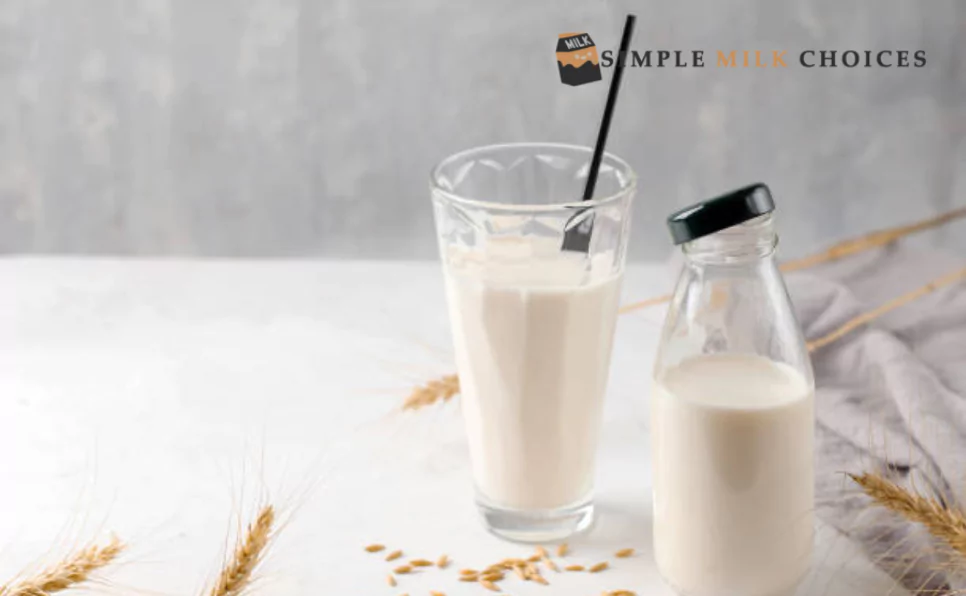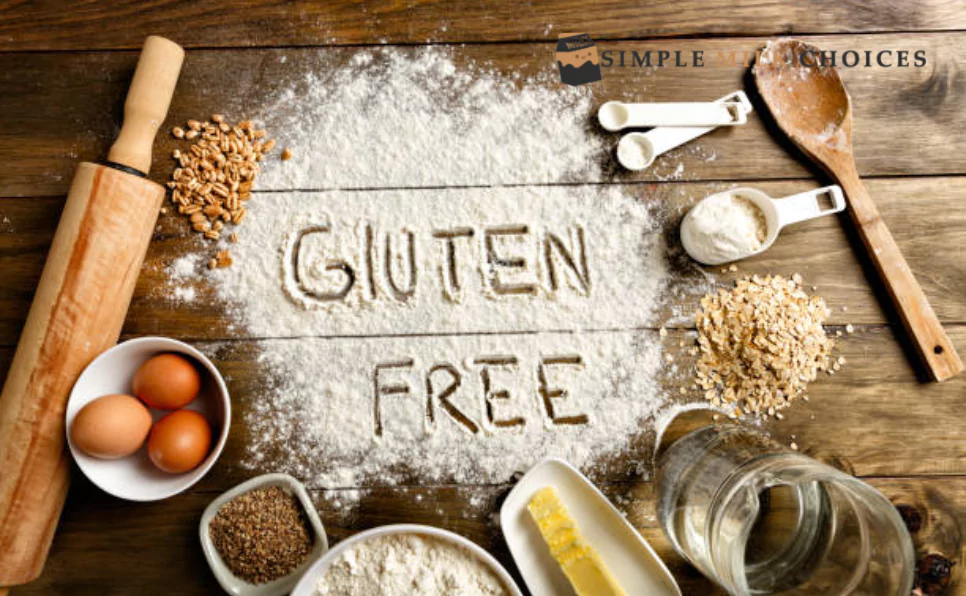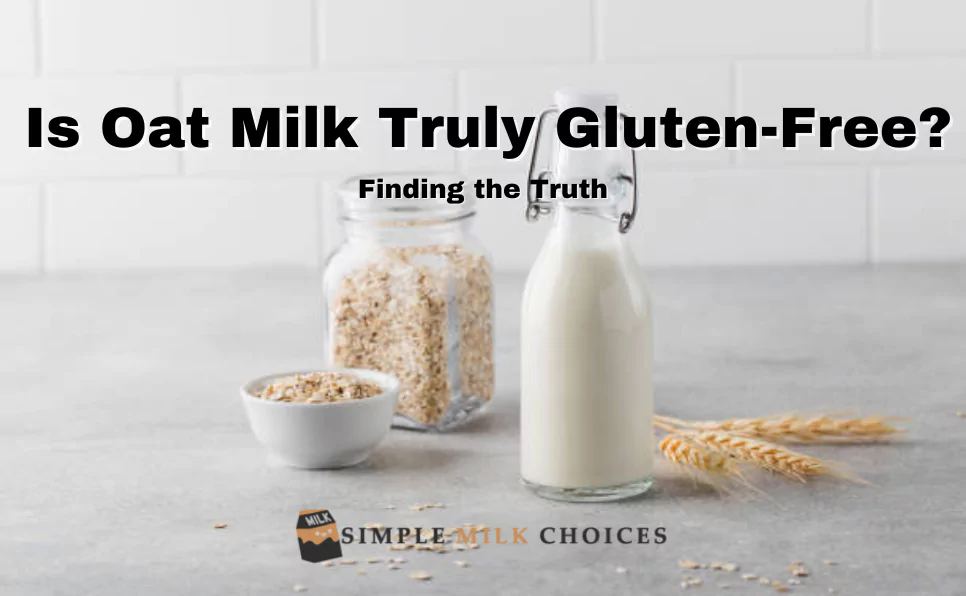In recent years, the racks of supermarkets have been decorated with a newbie in the realm of plant-based milks: oat milk. Its velvety surface, gentle taste, and eco-accommodating growth have pushed it into the spotlight, making it a top decision for some looking for dairy options. However, in the middle of its rising popularity, an important issue remains: Is oat milk truly gluten-free?
Oat milk’s rise in popularity isn’t just a trend; it reflects how people prefer more eco-friendly, plant-based options. This change in consumer preferences has caused a flood in oat milk’s popularity. However, settled inside this excitement lies a discussion that has blended interest and concern for the same: the gluten-free status of oat milk. While oats themselves are normally without gluten, the cycle involved with delivering oat milk has brought up issues about its health for those with gluten sensitivities or celiac infection.
This blog plans to look profoundly into the core of this discussion, investigating the subtleties and complexities encompassing oat milk and its gluten content. All through this investigation, we’ll explore the scene of oat milk creation, examine the elements impacting its gluten content, and filter through logical examination and well-qualified conclusions.
Stay tuned as we take apart the different points of view, separate reality from fiction, and eventually shed light on whether oat milk genuinely remains a solid without gluten. This blog is prepared to give you clear information, whether you’re health-conscious, have gluten sensitivities, or are simply curious about oat milk. It aims to provide the clarity you seek on the subject.
Understanding Gluten and its Impact
Gluten, a protein found in wheat, barley, and rye, plays a crucial role in the texture and flexibility of various foods. It contributes significantly to how different foods feel and hold together. When gluten and gliadin proteins join with water, they create a sticky mixture that gives dough its stretchiness. This combination forms when two proteins, gluten and gliadin, come together with water.
How Does Gluten Affect Individuals with Gluten Sensitivity or Celiac Disease?
People with gluten awareness or celiac illness experience antagonistic responses when they consume gluten-containing food sources. For those with celiac sickness, an immune system issue, gluten sets off a sensitive reaction, harming the small digestive tract’s coating and prompting the malabsorption of supplements.
Gluten-responsiveness doesn’t involve the immune system. However, it can bring about symptoms similar to those of celiac disease, for example, swelling, loose bowels, or exhaustion. However, it’s vital to note that gluten responsiveness isn’t quite as extreme as celiac sickness and doesn’t bring about digestive harm.
Common Misconceptions about Gluten-Free Diets
Numerous misguided judgments include gluten-free slime. Some see them as a weight-reduction arrangement; however, dispensing with gluten doesn’t ensure weight loss. Others accept that going without gluten is innately better, but it might prompt an absence of fundamental supplements that are possibly not appropriately made. Understanding the subtleties of gluten awareness and celiac infection can assist with scattering these misinterpretations and guide people toward informed dietary decisions.
Oats and Gluten: Unraveling the Connection
Oats have long been hailed as a dietary wonder, offering numerous clinical benefits. However, their relationship with gluten has touched off a great deal of conversation and assessment. In this examination, we’ll explore the complex connection between oats and gluten. We’ll uncover insights into their natural components and the risks of contamination during processing. We’ll also focus on the crucial difference between purity protocols and mechanically or chemically separated oats.
Investigating the Regular Piece of Oats
At their core, oats are naturally gluten-free grains. They boast a rich, wholesome profile, loaded with fiber, nutrients, and minerals. This regular piece goes with them, a well-known decision for those looking for a healthy, gluten-free diet. However, the complexities lie in the handling and expected cross-pollution with gluten-containing grains.
Contamination Risk during Oat Processing
The excursion from ranch to table presents potential traps with regards to gluten tainting. Oats are often handled in offices that additionally handle wheat, grain, or rye, improving the probability of cross-contact. Oats, despite being gluten-free, can mistakenly retain minor amounts of gluten. This poses a risk for individuals with celiac disease or sensitivity to gluten.
Distinction between Purity Protocols and Mechanically or Chemically Separated Oats
It’s crucial to separate oats handled carefully from those separated mechanically or chemically. This helps maintain purity standards and ensures their distinction. Immaculateness conventions include rigid measures to prevent cross-tainting, ensuring the oats stay uncontaminated by gluten-containing grains. Then again, precisely or synthetically isolated oats use strategies to dispense with gluten in the wake of handling; however, these may not ensure total escape.
Also Read: What Oat Milk Does Dunkin Donuts Use?

Disclosing the Oat Milk Creation Cycle
Looking into the Specialty of Making Oat Milk
Oat milk, a rising star in the realm of plant-based alternative options, goes through a captivating change from humble oats to a smooth, dairy-free charm. We should take an excursion through the complicated strides of its creation.
Translating the Extraction Strategies of Oat Milk
The extraction of oat milk includes a fastidious interaction, enveloping different techniques to yield that smooth surface and particular flavor. Understanding these methods reveals insight into the imaginativeness behind each taste.
Exploring Gluten Cross-Infection in Oat Milk Manufacturing
For people sensitive to gluten, the chance of cross-contamination is a relevant worry during oat milk creation. Investigating potential places where gluten could meet with the cycle ensures a more secure item for all shoppers.
Stay tuned for an inside-out exploration into the universe of oat milk creation and the subtleties inside this prospering industry.
The Gluten-Free Certification of Oat Milk
Exploring the maze of gluten-free confirmations can be a challenge when it comes to buying gluten-free foods. In the domain of dairy choices, oat milk stands out for its rich surface and flexibility. However, for those with gluten-sensitive qualities or celiac infection, ensuring their health can be challenging. Exploring the certificates reveals how oat milk gets its gluten-free status. It shows the complex principles and consistent quality involved.
Certification Standards: A Range of Assurance
Gluten-free confirmation is certainly not a one-size-fits-all certification. Different guidelines exist, from the broadly perceived Gluten Free Certification Organization (GFCO) to country-explicit guidelines. Each sets its edges for gluten content, which can range from under 5 parts per million (ppm) as far as possible.
Sharing the Process: How Oat Milk goes Gluten-Free
The most common way of ensuring oat milk’s gluten-free status includes hard work by producers. Oats themselves don’t naturally contain gluten; however, cross-contamination during development, handling, or bundling can present dangers. Makers take specific steps in their offices, with equipment and purchasing practices, to prevent gluten exposure. This helps alleviate the risk of gluten being present in their products.
The path to creating gluten-free oat milk involves two key steps: first, securing oats that are guaranteed gluten-free; then, carefully testing them at various stages of production. This process demands strict protocols to ensure the final product is free from gluten. Cleaning strategies, isolation measures, and testing philosophies are critical to keeping up with consistency.
The Power of Third-Party Certifications
Third-party certifications serve as the foundation of confidence in the domain of gluten-free items. Their fairness and thorough assessment processes add validity. Certifications like GFCO or NSF Worldwide go through customary reviews and investigations, offering shoppers certification beyond simple manufacturer claims.
Unwavering Reliability In the midst of Complexity
While certificates give a feeling that everything is good, exploring the subtleties of naming the remaining parts without gluten is complex. Understanding of principles, varieties in testing techniques, and periodic debates feature the continuous test. Shoppers should stay careful, depending on trusted certificates and understanding the complexities in question.
The oat milk’s gluten-free certification showcases the business’s commitment to inclusivity and safety. This journey shows how things go from the field to retirement. As mindfulness develops and principles develop, the confirmation of sans-gluten oat milk keeps on being a difficult exercise of science, determination, and administrative consistency.

Common Misconceptions about Gluten in Oat Milk
Oat milk has acquired popularity as a non-dairy alternative; however, there are common misunderstandings about its gluten content. One of the essential errors is the presumption that all oat milk contains gluten. As opposed to this conviction, the presence of gluten in oat milk isn’t natural but rather depends on different variables.
Gluten is a protein tracked down in wheat, grain, and rye, yet oats themselves are innately without gluten. However, the cross-defilement that happens during handling can prompt gluten to be available in some oat-based items. This cross-tainting principally happens when oats are handled in offices that also handle gluten-containing grains.
To take special care of people sensitive to gluten, many brands have perceived this worry and produced oat milk marked “without gluten.” These items go through rigid measures to ensure a negligible risk of cross-pollution during handling. It’s fundamental for consumers to check for these names and select gluten-free oat milk if they have gluten-related health concerns.
Related Article: Can cats have oat milk?
Addressing Consumer Concerns about Gluten Cross-Contamination
For people with gluten-sensitive qualities or celiac illness, the risk of cross-defilement is a critical concern when picking oat milk. Manufacturers play a critical role in addressing these concerns by carrying out severe conventions to prevent gluten cross-contact during creation.
A few estimates taken by capable oat milk producers include:
Devoted Offices
A few brands process oats in offices completely differently from gluten-containing grains, fundamentally decreasing the risk of cross-tainting.
Testing and Certification
Thorough testing and certificate processes are embraced to ensure that the eventual outcome meets the model for being marked gluten-free. Search for certificates from respectable associations like the Gluten-Free Certification Organization (GFCO) or comparable administrative bodies.
Transparent Labeling
Organizations frequently give clear markings to show that their oat milk is gluten-free. This transparent labeling assists consumers with pursuing informed decisions in view of their dietary necessities.
It’s important for consumers to be attentive while choosing oat milk, particularly if they have gluten-related health concerns. Understanding labels, checking for certificates, and exploring brands can help with finding an item that lines up with specific dietary necessities.
Conclusion: Is Oat Milk Gluten-Free?
After exploring the domain of oat milk and its gluten-free status, it becomes clear that the answer is not a direct yes or no. Oats, in their normal structure, don’t intrinsically contain gluten. However it may be, the worry emerges from likely cross-tainting during handling.
With careful determination and thoughtfulness regarding labeling, people can appreciate oat milk without undermining their gluten-free dietary requirements.
FAQ’s
Is oat milk normally gluten-free?
Oats themselves don’t contain gluten; however, cross-tainting during handling can present gluten. Search for certified gluten-free oat milk to ensure it’s protected.
How can I tell if oat milk is gluten-free?
Really look at labels for the “ensured gluten-free” mark. Brands that thoroughly stick to gluten-free guidelines will frequently have this confirmation on their packaging.
Can individuals with celiac illness or gluten allergies drink oat milk?
It relies on oat milk’s creation cycle. Guaranteed-non-gluten oat milk is for the most part ok for those with celiac illness or gluten intolerance; however, consistently counsel medical services proficient if questionable.
What are the dangers of consuming normal oat milk for someone with gluten resistance?
Customary oat milk can contain certain measures of gluten because of cross-tainting, possibly making responses to those touchy glutens.
Are there options in contrast to oat milk for people staying away from gluten?
Yes, Plenty! Almond milk, coconut milk, rice milk, and soy milk are well known without gluten options, in contrast to oat milk.





